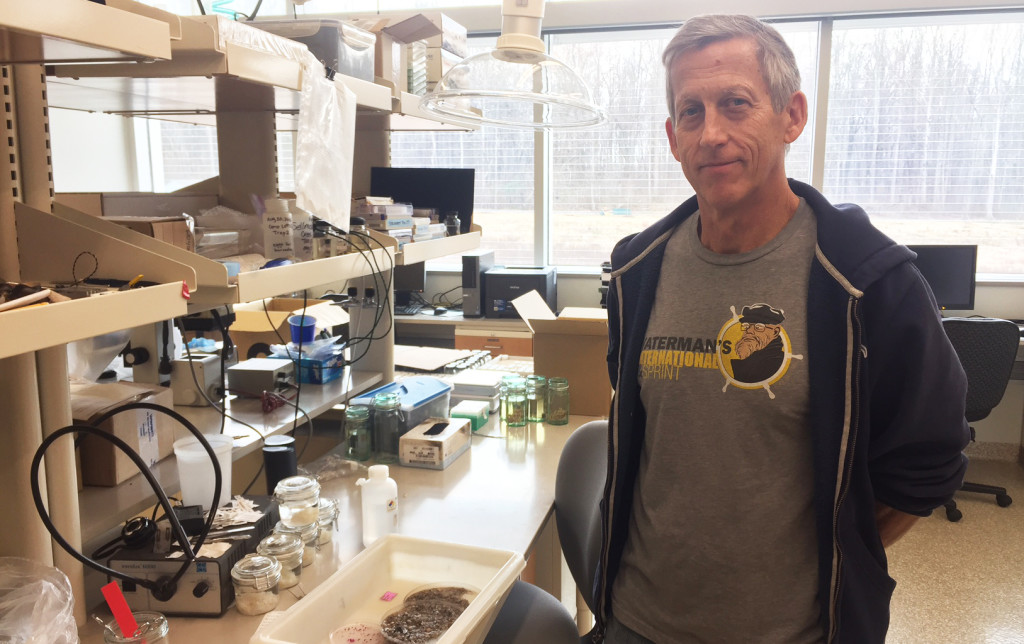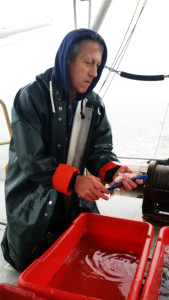by Sara Richmond

SERC citizen scientist Dave Norman stands beside a collection of sediment samples from the bottom of Chesapeake Bay. (Sara Richmond)
Dave Norman’s first visit to the Smithsonian Environmental Research Center (SERC) wasn’t to help with a field trip or assist researchers in the crab lab, as he has done for the past two years. In fact, he knew very little about SERC, but was competing in a triathlon on its campus. The experience stuck with him, and when he retired a year later, he contacted SERC to ask how he could get involved as a volunteer.
The volunteer program offered a mix of science and education opportunities that turned out to be a perfect fit for Dave. He says he was part of the “Jacques Cousteau generation,” who grew up with the explorer’s books and movies, and eventually started college with plans to become a marine biologist. Those plans changed—he would practice law for 30 years before becoming a seventh-grade math teacher—but when he retired, his love of the water brought him back to the field.
As a citizen science volunteer, Dave does hands-on projects with the ecologists of SERC’s Fish and Invertebrate Ecology Lab, affectionately known as the “crab lab” for its wealth of blue crab research. For example, he helps determine if the Chesapeake Bay holds enough food to support blue crab populations. To do this, he studies bottom samples of sand and other sediment taken from the Bay that SERC staff have stained so that anything that was living turns pink. He examines the samples under a microscope, noting which of the pink specimens are tiny animals and therefore potential food for the blue crab.

Dave Norman goes on trip to survey river herring with SERC’s Fish and Invertebrate Ecology Lab. (Kim Richie/SERC)
Dave also works on SERC’s River Herring Conservation Project. River herring spend most of their lives in the ocean but visit rivers and streams along the Chesapeake each spring to spawn. However, their populations have declined in recent decades, possibly due to overfishing, pollution, and the presence of dams and other structures that block them from spawning areas. The river herring project tracks herring spawning in Maryland and Virginia tributaries to determine if the fish are reaching their spawning grounds, or if human impacts are interfering. Using a net with a bottle attached to the end, Dave and other volunteers work with SERC to collect plankton samples from rivers. Then, they painstakingly examine the samples under a microscope, counting the number of herring eggs present to determine if herring are making it upstream to reproduce.
While laboratory work sometimes means working alone, Dave notes that this hasn’t been his experience at SERC. One of his favorite parts about volunteering with the citizen science program is that he gets to work as part of a team of other volunteers and researchers. He also enjoys participating in field work that frequently takes him out on the water, such as day-long trips collecting herring samples in Maryland and Virginia.
And, some days, he joins the education crew in leading field trips. “It’s a teacher’s dream come true to teach in a setting like SERC,” he says. “It’s really engaging and eye-opening for students.” He hopes that students leave SERC with a greater appreciation of the natural world, which he believes is a first step to growing future environmental advocates. “And if they retain anything about habitat, water quality, and the other lessons we try to teach them while they’re here, all the better,” he says.
He encourages others who are thinking about volunteering to “jump in with both feet,” especially if they have an interest in nature or nature education, working with kids, or working with collaborative teams. Even though people don’t have to volunteer (or compete in a triathlon) to visit, he says, “it’s a beautiful setting to work in, and the work is rewarding. It’s a hands-on opportunity to work alongside SERC investigators, and they provide you with context as to how it fits into the other research here and its relevance.”
Want to join the team? Contact Karen McDonald (Education) or Alison Cawood (Citizen Science).


Kudos to Dave and the other citizen scientists! I never would have completed my dissertation research on butterfly ecology without the help of many volunteers!